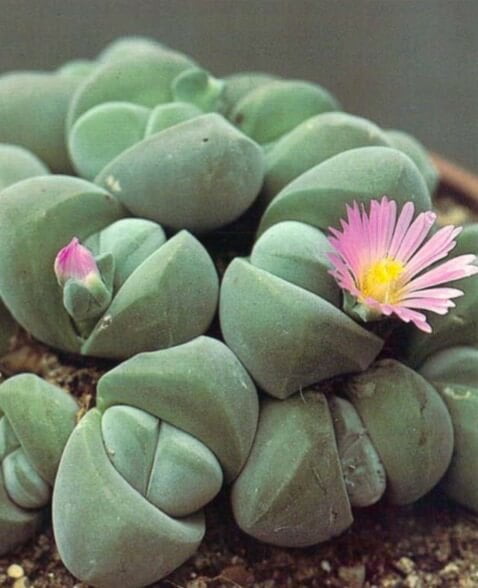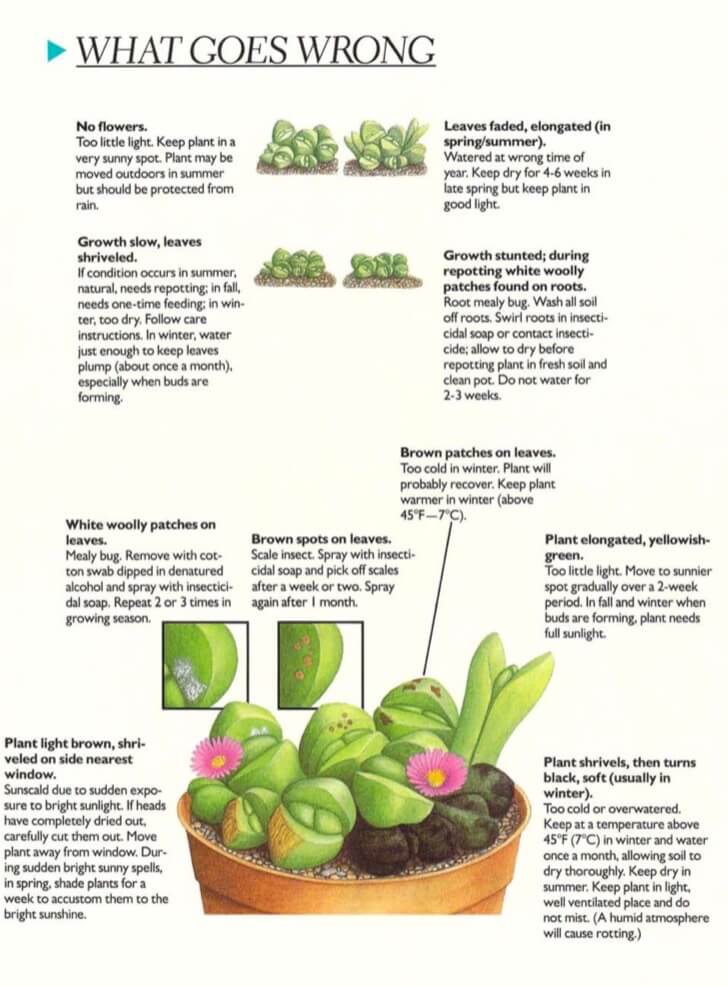[Ebook Việt Hoá] The Instant Guide to Healthy Houseplants (Hướng dẫn tức thời để chăm cây trong nhà khoẻ mạnh), Chi Gibbaeum
[Ebook Việt Hoá] The Instant Guide to Healthy Houseplants: Gibbaeum dispar (Flowering quartz)
- Nguồn: [Ebook Việt Hoá] The Instant Guide to Healthy Houseplants (Hướng dẫn tức thời để chăm cây trong nhà khoẻ mạnh)
- Biên tập: Dũng Cá Xinh
- Biên dịch: Team Codai.net
English
This succulent, native to South Africa, has an unusual growing pattern; its growing season is late autumn and winter, and it usually produces its purple-red flowers in spring. It grows to about 1 1/2 inches (3 cm) high and covers a base area of 4 inches (10 cm). Other species not easy to obtain but worth seeking out from specialty houses are C . album, with white or pink flowers; C. pubescens or G. shandii, with violet-red flowers; and G. velutinum, with lilac-pink flowers.

Light
Needs full sunlight, especially in fall and winter when buds are forming. During sudden sunny spells in spring, ensure good air circulation and shade plant for a week so it can acclimate.
Temperature
Keep temperature above a winter minimum of 45°F (7°C). Provide fresh air in hot weather.
Water
This plant’s resting period is late spring/early summer, not winter. Water every 14 days in early spring. After plant has flowered, keep it dry for 4-6 weeks, then resume watering every 14 days in late summer. In autumn and winter water once a month, allowing soil to dry between waterings.
Feeding
Feeding is not necessary if plant has been repotted within 2 years. If it has not been repot- ted recently, give a one-time application of high-potash liquid fertilizer in the fall.
Soil
Use a loam-based potting soil or soilless mix with 40% coarse, gritty sand.
Repotting
When roots fill the pot, repot in next size half-pot or pan; or repot every 3 years in same size half-pot or pan with fresh soil. Do not water for 3 weeks after repotting.
Propagation
Propagate by division in summer. With a sharp knife separate heads to use as cuttings. (Growing plants from seed is difficult.)
Treating roots
Gibbaeum has unusually thick tumiplike roots that are very susceptible to root mealy bug. Always check roots for root mealy bug when repotting plant. If mealy bugs are found, wash soil off roots and soak roots for 5 minutes in bowl of insecticidal soap at manufacturer’s recommended strength. Rinse with water and allow to dry for 2 days. Repot in fresh, dry soil and clean pot. Do not water again for 2-3 weeks.

What Goes Wrong

- No flowers: Too little light. Keep plant in a very sunny spot. Plant may be moved outdoors in summer but should be protected from rain.
- Growth slow, leaves shriveled: If condition occurs in summer, natural, needs repotting; in fall, needs one-time feeding; in winter, too dry. Follow care instructions. In winter, water just enough to keep leaves plump (about once a month), especially when buds are forming.
- White woolly patches on leaves: Mealy bug. Remove with cotton swab dipped in denatured alcohol and spray with insecticidal soap. Repeat 2 or 3 times in growing season.
- Plant light brown, shriveled on side nearest window: Sunscald due to sudden exposure to bright sunlight. If heads have completely dried out, carefully cut them out. Move plant away from window. During sudden bright sunny spells, in spring, shade plants for a week to accustom them to the bright sunshine.
- Brown spots on leaves: Scale insect. Spray with insecticidal soap and pick off scales after a week or two. Spray again after 1 month.
- Plant elongated, yellowish green: Too little light. Move to sunnier spot gradually over a 2-week period. In fall and winter when buds are forming, plant needs full sunlight.
- Plant shrivels, then turns black, soft (usually in winter): Too cold or overwatered. Keep at a temperature above 45°F(rq in winter and water once a month, allowing soil to dry thoroughly. Keep dry in summer. Keep plant in light, well ventilated place and do not mist. (A humid atmosphere will cause rotting.)
- Leaves faded, elongated (in spring/summer): Watered at wrong time of year. Keep dry for 4-6 weeks in late spring but keep plant in good light.
- Growth stunted; during repotting white woolly patches found on roots: Root mealy bug. Wash all soil off roots. Swirl roots in insecticidal soap or contact insecticide; allow to dry before repotting plant in fresh soil and clean pot. Do not water for 2-3 weeks.
- Brown patches on leaves: Too cold in winter. Plant will probably recover. Keep plant warmer in winter (above 45°F-7°C).
Tiếng Việt
Loại xương rồng này có nguồn gốc từ Nam Phi, có kiểu phát triển khác thường; mùa phát triển của nó là vào cuối mùa thu và mùa đông và nó thường ra hoa màu đỏ tím vào mùa xuân. Nó phát triển cao đến khoảng 1 1/2 inch (3 cm) và có diện tích cơ bản là 4 inch (10 cm). Các loài khác không dễ kiếm nhưng đáng tìm mua ở các cửa hàng chuyên cây là C. album có hoa màu trắng hoặc hồng; C. pubescens hoặc G. shandii có hoa màu đỏ tím; và G. velutinum với hoa màu hồng và màu hoa cà.

Ánh sáng
Cần ánh sáng mặt trời đầy đủ, đặc biệt là vào mùa thu và mùa đông khi chồi đang hình thành. Trong những đợt nắng đột ngột vào mùa xuân, hãy đảm bảo không khí lưu thông tốt và che mát cho cây trong một tuần để cây có thể thích nghi.
Nhiệt độ
Giữ nhiệt độ trên mùa đông tối thiểu là 45 ° F (7 ° C). Cung cấp không khí trong lành trong thời tiết nắng nóng.
Nước
Thời gian nghỉ ngơi của cây này là cuối mùa xuân / đầu mùa hè, không phải mùa đông. Tưới nước 14 ngày một lần vào đầu mùa xuân. Sau khi cây ra hoa, giữ khô trong 4-6 tuần, sau đó tiếp tục tưới 14 ngày một lần vào cuối mùa hè. Vào mùa thu và mùa đông tưới nước mỗi tháng một lần, để đất khô giữa các lần tưới.
Bón phân
Không cần bón phân nếu cây đã được thay chậu trong vòng 2 năm. Nếu nó chưa được thay gần đây, hãy bón một lần phân bón lỏng có hàm lượng kali cao vào mùa thu.
Đất
Sử dụng đất bầu pha mùn hoặc hỗn hợp không có đất với 40% cát thô.
Thay chậu
Khi rễ mọc đầy chậu, hãy thay vào chậu hoặc chảo có kích thước tiếp theo; hoặc thay chậu 3 năm một lần trong chậu có cùng kích thước với đất mới. Không tưới nước trong vòng 3 tuần sau khi thay chậu.
Nhân giống
Nhân giống bằng cách phân chia trong mùa hè. Với một con dao sắc nhọn tách đầu để sử dụng. (Trồng cây từ hạt rất khó.)
Xử lý rễ
Gibbaeum có bộ rễ dày bất thường rất dễ bị rệp sáp. Luôn luôn kiểm tra rễ xem có rệp sáp rễ khi thay chậu cho cây. Nếu phát hiện thấy rệp, rửa sạch đất khỏi rễ và ngâm rễ 5 phút trong xà phòng diệt côn trùng theo khuyến cáo của nhà sản xuất. Rửa sạch bằng nước và để khô trong 2 ngày. Thay chậu trong đất khô, sạch và chậu sạch. Không tưới lại trong 2-3 tuần.

Những vấn đề có thể xảy ra

- Không có hoa: Quá ít ánh sáng. Để cây ở nơi có nhiều nắng. Có thể chuyển cây ra ngoài trời vào mùa hè nhưng cần tránh mưa.
- Sinh trưởng chậm, lá teo tóp: Nếu gặp tình trạng vào mùa hè, tự nhiên, cần thay chậu; vào mùa thu, cần bón phân một lần; vào mùa đông, quá khô. Làm theo hướng dẫn chăm sóc. Vào mùa đông, tưới nước vừa đủ để giữ cho lá tươi tốt (khoảng một tháng một lần), đặc biệt là khi chồi đang mọc.
- Các mảng lông tơ màu trắng trên lá: Rệp sáp. Dùng bằng tăm bông nhúng vào cồn biến tính và xịt xà phòng diệt côn trùng. Lặp lại 2 hoặc 3 lần trong mùa sinh trưởng.
- Trồng cây có màu nâu nhạt, nhăn nheo: Cháy nắng do tiếp xúc đột ngột với ánh sáng mặt trời chói chang. Nếu đầu đã khô hoàn toàn, hãy cẩn thận cắt chúng ra. Di chuyển cây ra xa cửa sổ. Trong những đợt nắng chói chang đột ngột, vào mùa xuân, che mát cho cây trong một tuần để chúng quen với ánh nắng chói chang.
- Đốm nâu trên lá: Sâu bọ. Xịt xà phòng diệt côn trùng và loại bỏ vảy sau một hoặc hai tuần. Xịt lại sau 1 tháng.
- Cây thân dài, màu xanh vàng: Quá ít ánh sáng. Di chuyển dần đến vị trí có ánh nắng mặt trời trong khoảng thời gian 2 tuần. Vào mùa thu và mùa đông khi chồi đang hình thành, cây cần đầy đủ ánh sáng mặt trời.
- Cây teo tóp, sau đó chuyển sang màu đen, mềm (thường xảy ra vào mùa đông): Quá lạnh hoặc bị ngập úng. Giữ ở nhiệt độ trên 45 ° F ( 7°C) vào mùa đông và tưới nước mỗi tháng một lần, để đất khô hoàn toàn. Giữ khô ráo vào mùa hè. Để cây ở nơi có ánh sáng, thông gió tốt và không phun sương. (Không khí ẩm ướt sẽ làm thối rữa). )
- Lá héo úa, dài ra (vào mùa xuân / hè): Tưới không đúng thời điểm trong năm. Giữ khô trong 4-6 tuần vào cuối mùa xuân nhưng giữ cho cây có ánh sáng tốt.
- Tăng trưởng còi cọc; trong quá trình thay chậu, các mảng lông tơ màu trắng được tìm thấy trên rễ: Rệp sáp. Rửa sạch đất khỏi rễ. Xoáy rễ trong xà phòng diệt côn trùng hoặc thuốc trừ sâu tiếp xúc; Để khô trước khi thay chậu vào đất sạch và chậu sạch. Không tưới trong 2-3 tuần.
- Các mảng màu nâu trên lá: Quá lạnh vào mùa đông. Cây có thể sẽ phục hồi. Giữ ấm hơn cho cây vào mùa đông (trên 45 ° F-7 ° C).
![[Ebook Việt Hoá] The Instant Guide to Healthy Houseplants: Gibbaeum dispar (Flowering quartz) [Ebook Việt Hoá] The Instant Guide to Healthy Houseplants: Gibbaeum dispar (Flowering quartz)](https://vn1.vdrive.vn/codai.net/2020/02/ebook-huong-dan-tuc-thoi-cham-cay-trong-nha-khoe-manh-109-gibbaeum-dispar.jpg)


